Abstract
In order to complete the immunodiagnosis of human toxocaral disease, an immunoenzymatic assay with excretory-secretory antigens from Toxocara canis larvae was developed for the detection of specific immunoglobulin E (sIgE enzyme-linked immunosorbent assay [ELISA]). The specificity of the assay was evaluated in patients presenting with various allergic or helminthic diseases. The sensitivity was assessed in patients exhibiting clinical and biological symptoms indicative of toxocariasis, serodiagnosis of which was made by the Western blot (WB; immunoblot) procedure that used the same antigen as that used in the sIgE ELISA but that detected specific IgG. The value of the sIgE ELISA for posttreatment follow-up was tested in two groups of patients: one group was treated with diethylcarbamazine; the other group was not treated with DEC. Results showed that the specificity and sensitivity of the sIgE ELISA were moderate. Thus, the sIgE ELISA appeared to be insufficient for properly ensuring the serodiagnosis of toxocariasis when it is used alone. However, sIgE ELISA might be an interesting complementary method for the detection of specific IgG. It was the only assay that was found to be positive in sera from some hypereosinophilic patients. sIgE ELISA values decreased significantly among the patients treated with DEC, indicating that this test would be useful for posttreatment follow-up assessment.
Full text
PDF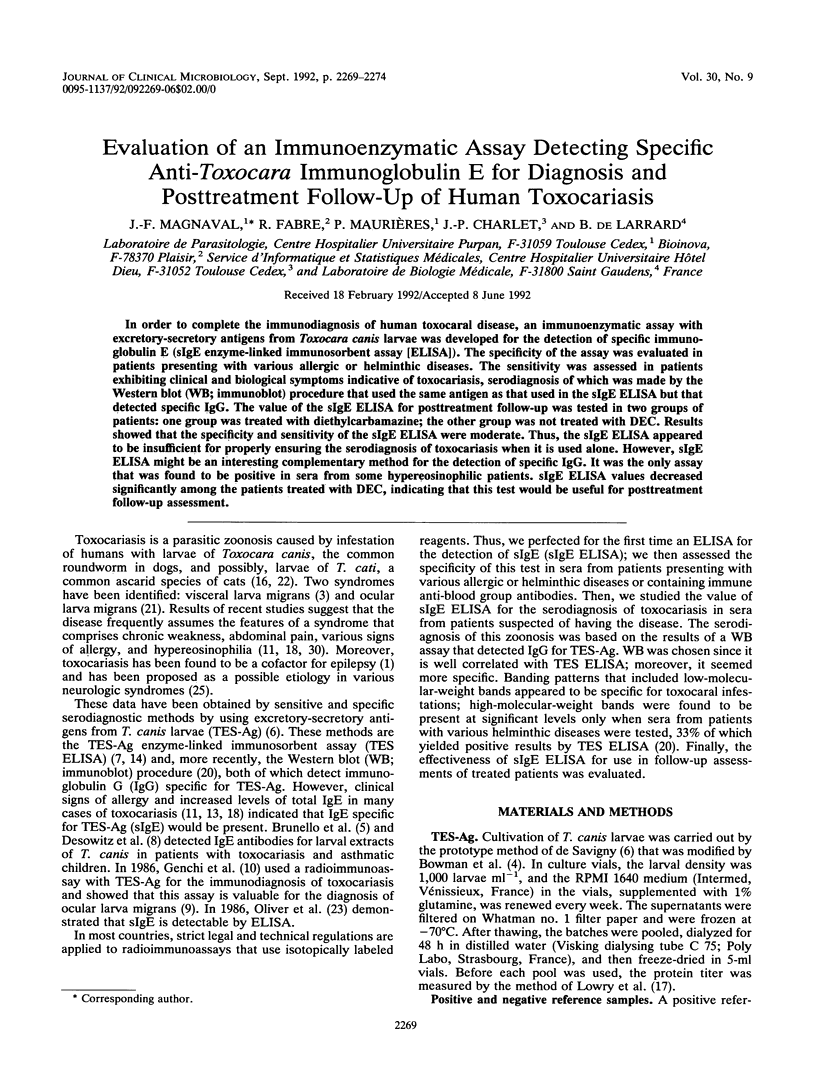
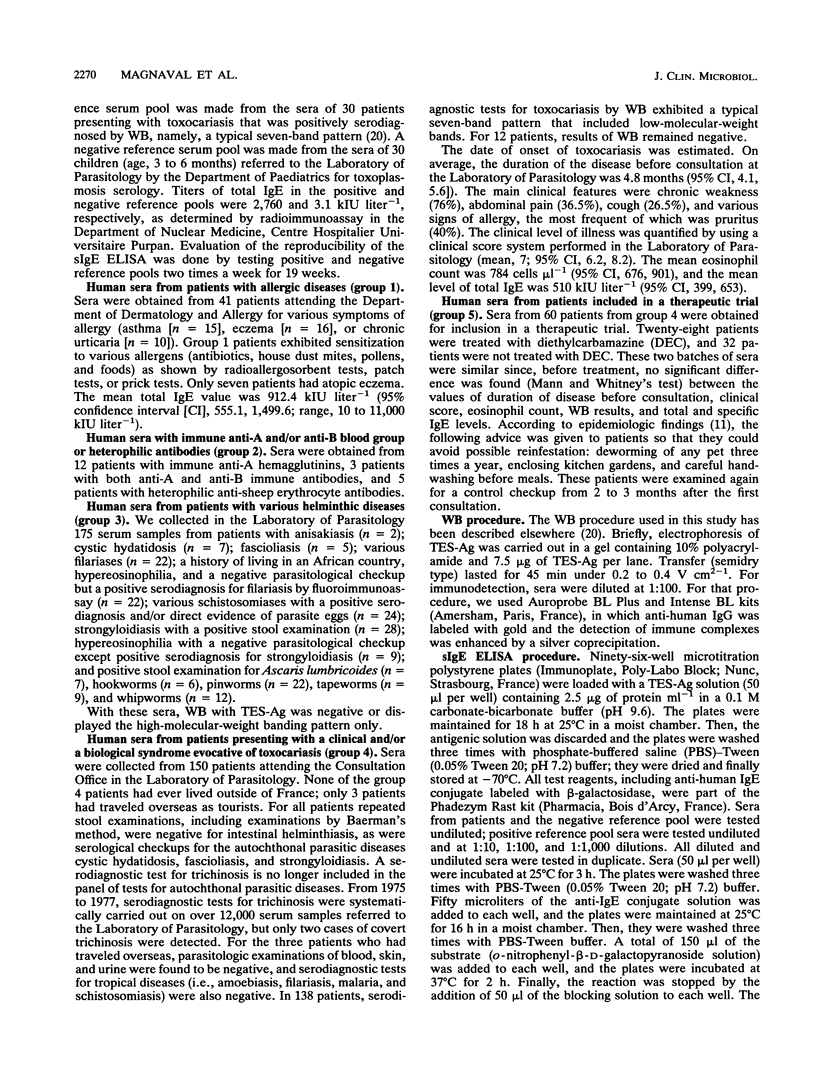
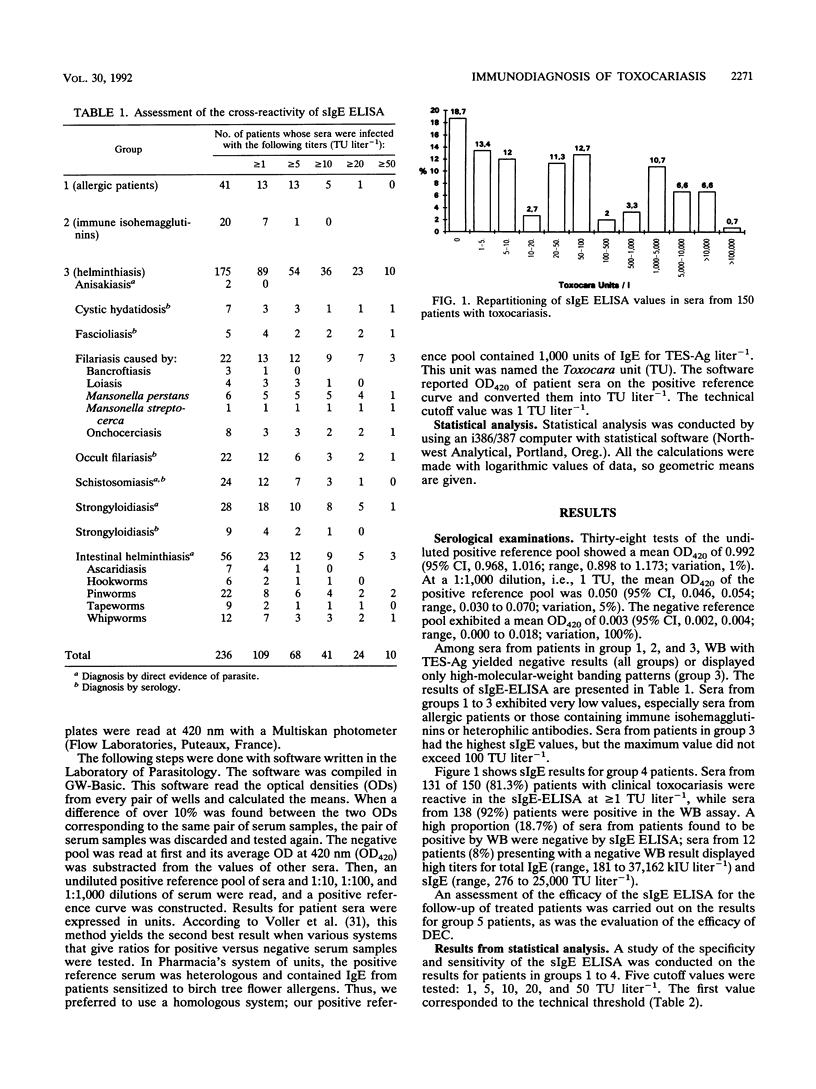
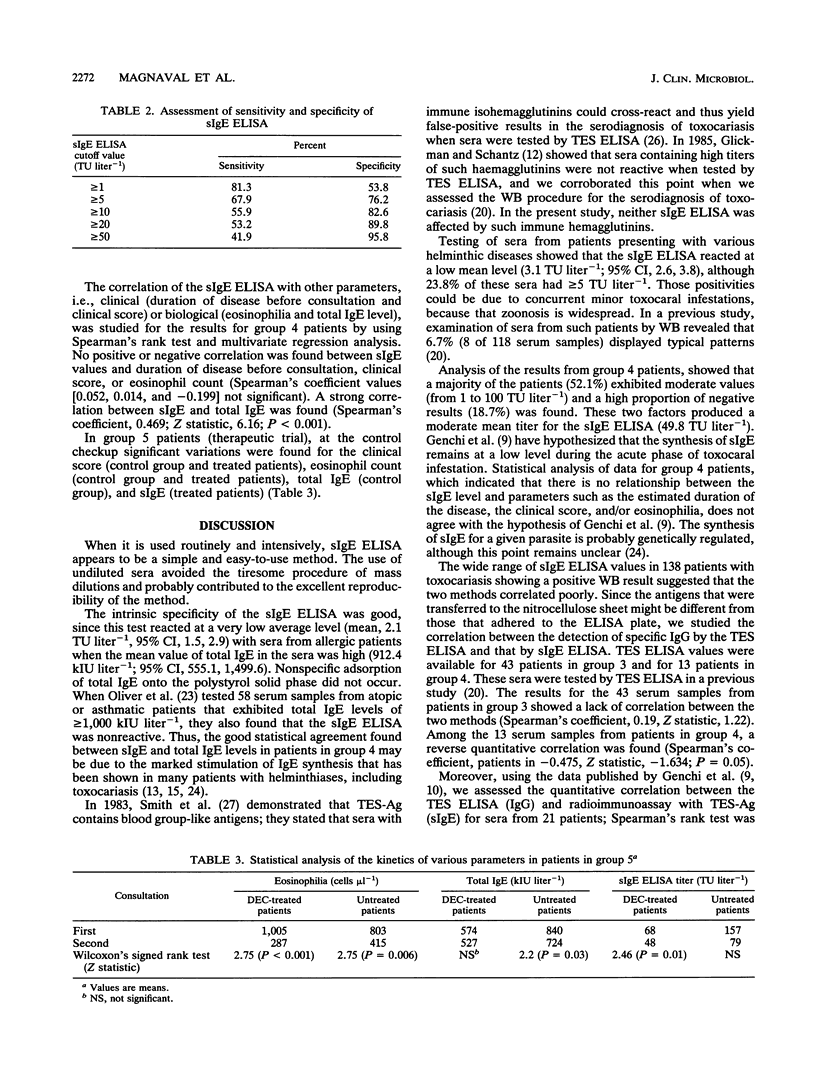
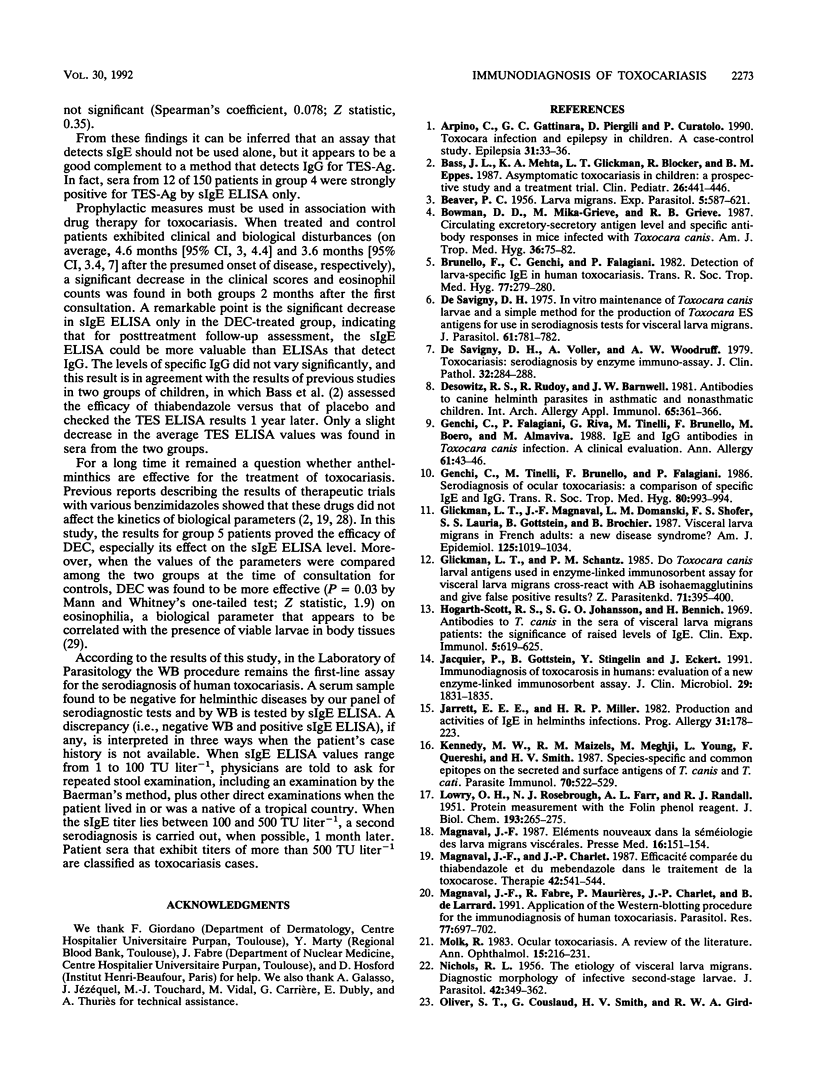
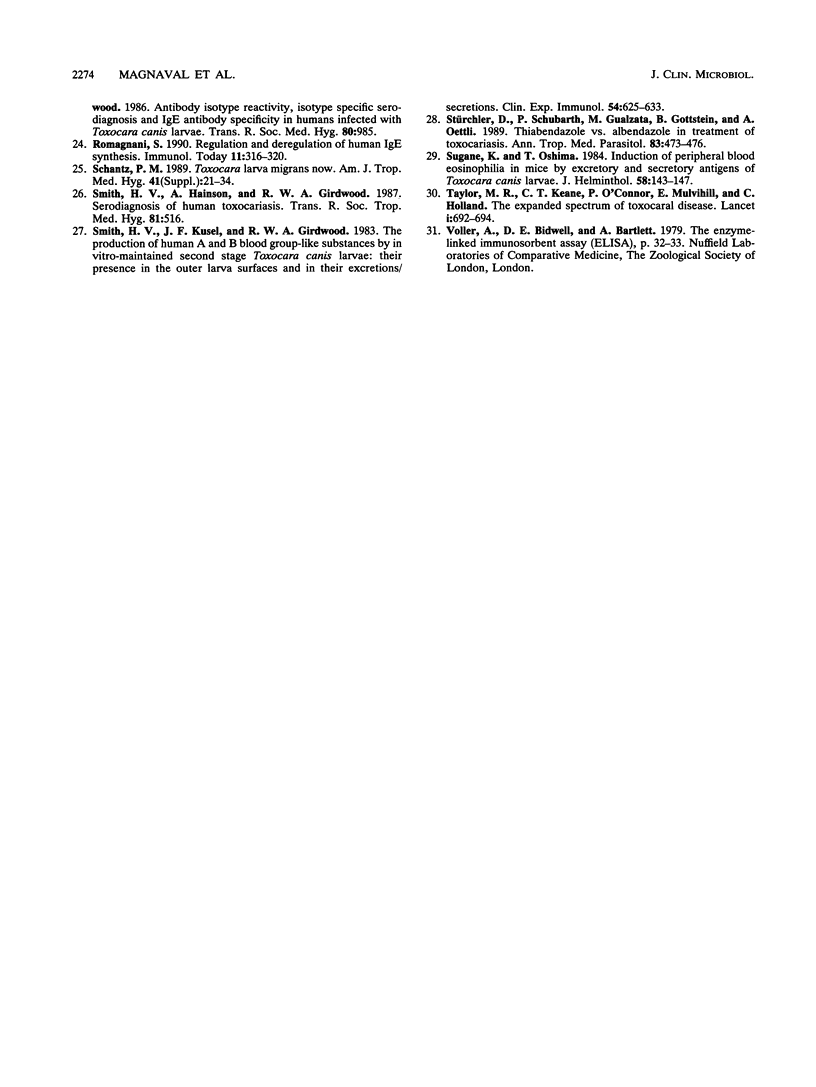
Selected References
These references are in PubMed. This may not be the complete list of references from this article.
- Arpino C., Gattinara G. C., Piergili D., Curatolo P. Toxocara infection and epilepsy in children: a case-control study. Epilepsia. 1990 Jan-Feb;31(1):33–36. doi: 10.1111/j.1528-1157.1990.tb05356.x. [DOI] [PubMed] [Google Scholar]
- BEAVER P. C. Larva migrans. Exp Parasitol. 1956 Nov;5(6):587–621. doi: 10.1016/0014-4894(56)90032-7. [DOI] [PubMed] [Google Scholar]
- Bass J. L., Mehta K. A., Glickman L. T., Blocker R., Eppes B. M. Asymptomatic toxocariasis in children. A prospective study and treatment trial. Clin Pediatr (Phila) 1987 Sep;26(9):441–446. doi: 10.1177/000992288702600902. [DOI] [PubMed] [Google Scholar]
- Bowman D. D., Mika-Grieve M., Grieve R. B. Circulating excretory-secretory antigen levels and specific antibody responses in mice infected with Toxocara canis. Am J Trop Med Hyg. 1987 Jan;36(1):75–82. doi: 10.4269/ajtmh.1987.36.75. [DOI] [PubMed] [Google Scholar]
- Brunello F., Genchi C., Falagiani P. Detection of larva-specific IgE in human toxocariasis. Trans R Soc Trop Med Hyg. 1983;77(2):279–280. doi: 10.1016/0035-9203(83)90096-2. [DOI] [PubMed] [Google Scholar]
- Desowitz R. S., Rudoy R., Barnwell J. W. Antibodies to canine helminth parasites in asthmatic and nonasthmatic children. Int Arch Allergy Appl Immunol. 1981;65(4):361–366. doi: 10.1159/000232777. [DOI] [PubMed] [Google Scholar]
- Genchi C., Falagiani P., Riva G., Tinelli M., Brunello F., Boero M., Almaviva M. IgE and IgG antibodies in Toxocara canis infection. A clinical evaluation. Ann Allergy. 1988 Jul;61(1):43–46. [PubMed] [Google Scholar]
- Genchi C., Tinelli M., Brunello F., Falagiani P. Serodiagnosis of ocular toxocariasis: a comparison of specific IgE and IgG. Trans R Soc Trop Med Hyg. 1986;80(6):993–994. doi: 10.1016/0035-9203(86)90286-5. [DOI] [PubMed] [Google Scholar]
- Glickman L. T., Magnaval J. F., Domanski L. M., Shofer F. S., Lauria S. S., Gottstein B., Brochier B. Visceral larva migrans in French adults: a new disease syndrome? Am J Epidemiol. 1987 Jun;125(6):1019–1034. doi: 10.1093/oxfordjournals.aje.a114618. [DOI] [PubMed] [Google Scholar]
- Glickman L. T., Schantz P. M. Do Toxocara canis larval antigens used in enzyme-linked immunosorbent assay for visceral larva migrans cross-react with AB isohemagglutinins and give false positive results? Z Parasitenkd. 1985;71(3):395–400. doi: 10.1007/BF00928341. [DOI] [PubMed] [Google Scholar]
- Hogarth-Scott R. S., Johansson S. G., Bennich H. Antibodies to Toxocara in the sera of visceral larva migrans patients: the significance of raised levels of IgE. Clin Exp Immunol. 1969 Dec;5(6):619–625. [PMC free article] [PubMed] [Google Scholar]
- Jacquier P., Gottstein B., Stingelin Y., Eckert J. Immunodiagnosis of toxocarosis in humans: evaluation of a new enzyme-linked immunosorbent assay kit. J Clin Microbiol. 1991 Sep;29(9):1831–1835. doi: 10.1128/jcm.29.9.1831-1835.1991. [DOI] [PMC free article] [PubMed] [Google Scholar]
- Jarrett E. E., Miller H. R. Production and activities of IgE in helminth infection. Prog Allergy. 1982;31:178–233. [PubMed] [Google Scholar]
- LOWRY O. H., ROSEBROUGH N. J., FARR A. L., RANDALL R. J. Protein measurement with the Folin phenol reagent. J Biol Chem. 1951 Nov;193(1):265–275. [PubMed] [Google Scholar]
- Magnaval J. F., Charlet J. P. Efficacité comparée du thiabendazole et du mébendazole dans le traitement de la toxocarose. Therapie. 1987 Oct-Dec;42(6):541–544. [PubMed] [Google Scholar]
- Magnaval J. F. Eléments nouveaux dans la séméiologie des "larva migrans" viscérales. Presse Med. 1987 Feb 7;16(4):151–154. [PubMed] [Google Scholar]
- Magnaval J. F., Fabre R., Maurières P., Charlet J. P., de Larrard B. Application of the western blotting procedure for the immunodiagnosis of human toxocariasis. Parasitol Res. 1991;77(8):697–702. doi: 10.1007/BF00928685. [DOI] [PubMed] [Google Scholar]
- Molk R. Ocular toxocariasis: a review of the literature. Ann Ophthalmol. 1983 Mar;15(3):216-9, 222-7, 230-1. [PubMed] [Google Scholar]
- NICHOLS R. L. The etiology of visceral larva migrans. I. Diagnostic morphology of infective second-stage Toxocara larvae. J Parasitol. 1956 Aug;42(4 SECTION):349–362. [PubMed] [Google Scholar]
- Romagnani S. Regulation and deregulation of human IgE synthesis. Immunol Today. 1990 Sep;11(9):316–321. doi: 10.1016/s0167-5699(10)80004-0. [DOI] [PubMed] [Google Scholar]
- Savigny D. H. In vitro maintenance of Toxocara canis larvae and a simple method for the production of Toxocara ES antigen for use in serodiagnostic tests for visceral larva migrans. J Parasitol. 1975 Aug;61(4):781–782. [PubMed] [Google Scholar]
- Schantz P. M. Toxocara larva migrans now. Am J Trop Med Hyg. 1989 Sep;41(3 Suppl):21–34. doi: 10.4269/ajtmh.1989.41.21. [DOI] [PubMed] [Google Scholar]
- Smith H. V., Hainson A., Girdwood R. W. Serodiagnosis of human toxocariasis. Trans R Soc Trop Med Hyg. 1987;81(3):516–516. doi: 10.1016/0035-9203(87)90186-6. [DOI] [PubMed] [Google Scholar]
- Smith H. V., Kusel J. R., Girdwood R. W. The production of human A and B blood group like substances by in vitro maintained second stage Toxocara canis larvae: their presence on the outer larval surfaces and in their excretions/secretions. Clin Exp Immunol. 1983 Dec;54(3):625–633. [PMC free article] [PubMed] [Google Scholar]
- Stürchler D., Schubarth P., Gualzata M., Gottstein B., Oettli A. Thiabendazole vs. albendazole in treatment of toxocariasis: a clinical trial. Ann Trop Med Parasitol. 1989 Oct;83(5):473–478. doi: 10.1080/00034983.1989.11812374. [DOI] [PubMed] [Google Scholar]
- Sugane K., Oshima T. Induction of peripheral blood eosinophilia in mice by excretory and secretory antigen of Toxocara canis larvae. J Helminthol. 1984 Jun;58(2):143–147. doi: 10.1017/s0022149x00028674. [DOI] [PubMed] [Google Scholar]
- de Savigny D. H., Voller A., Woodruff A. W. Toxocariasis: serological diagnosis by enzyme immunoassay. J Clin Pathol. 1979 Mar;32(3):284–288. doi: 10.1136/jcp.32.3.284. [DOI] [PMC free article] [PubMed] [Google Scholar]


